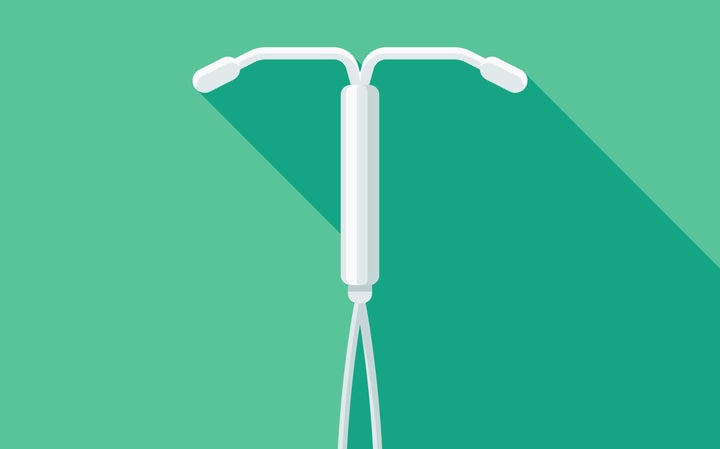
Intrauterine devices are becoming increasingly more common in the United States (although the birth control method is still not nearly as popular as others like the pill). People love them for a reason. They last a long time and they boast a near-foolproof degree of protection, with some covering you for up to 10 years. But there’s one major gripe many have with the birth control tool: The insertion can hurt like hell.
What does it feel like, exactly? You can think of it like a series of intense cramps or pain, which “can be worse for some,” according to Planned Parenthood. In Cosmopolitan’s reporting, some women say it “hurt less than a bikini wax,” while others claim it’s “about five seconds of the worst pain I’ve ever felt in my life.” Oy.
Basically everyone’s experience is a little different, but if you haven’t ever had an IUD, it’s just best to be fully prepared for the pain going in, said Mary Rosser, an assistant professor of obstetrics and gynecology at Columbia University Medical Center.
“It’s a fabulous method of birth control,” she said. “But it’s important to set expectations about the pain, while understanding that everyone has a different pain threshold.”
Neha Bhardwaj, an assistant professor of obstetrics, gynecology and reproductive science at Mount Sinai Hospital, said she tries to be upfront with her patients that the procedure is “uncomfortable,” even though the entire insertion process usually lasts under five minutes.
Why On Earth An IUD Insertion Is So Painful

To understand why the pain occurs, it’s important to understand the entire procedure. During an IUD insertion, the pain happens in steps.
After counseling the patient and getting consent, your doctor will “insert the speculum like she might during a pap smear,” Rosser said. She will clean your cervix with a solution that will prevent infection, while also stabilizing the cervix with a tool called the tenaculum. All the tools used are completely sterile, and you’ll probably feel the first major cramp during this phase.
After stabilizing the cervix, your doctor will tell you to take deep breaths. “From here, we use a tool [called the sound] to measure the length of the patient’s cervical canal and uterus,” Bhardwaj said. “This is the second big cramp you’ll feel.” If your doctor can’t get the slim instrument through the cervix, she may have to use medication to dilate the cervix.
It’s important that your doctor knows the length and direction of your cervix and uterus to reduce the risk of perforation, where the IUD might go through the uterine wall. In rare cases, a uterus might be too small for an IUD ― in which case, you’d want to discuss alternative methods of birth control with your physician.
Cramp number three is the last one. “Finally, you’ll feel the third cramp when the IUD is actually going in,” Bhardwaj said. The IUD is placed according to the sound’s measurements, using a tube-like inserter that plunges the device into the right spot in the uterus. Once in place, your gyno will trim the IUD strings to roughly 2.5 or 3 centimeters.
Yes, stabilizing the cervix, measuring everything and inserting the IUD each cause cramps, which will undoubtedly cause pain. It’s common to feel lightheaded during or after the procedure. But it’s important to remember the process is only a few minutes total ― and both doctors insist that medical staff will be in no rush to get you out of the exam room after your IUD is set.
“We have patients just lay down or sit for a while,” Rosser said. “In our office, we also do a bedside sonogram right there to check and make sure the IUD is in the right place.”
How To Make The Pain More Tolerable

While this process might seem overwhelming, there are a slew of things you can do to make your IUD insertion easier and less painful. Make sure to take two ibuprofen before you come into the office, about one or two hours prior to the start of your insertion, Bhardwaj said. Rosser suggested eating a little bit before the procedure, too. “The dilation especially can make you lightheaded,” she explained.
You can also ask for the local cervical numbing block, which is administered through two to five injections in the cervical canal at the time of the insertion. “This should reduce the discomfort of the procedure overall,” Bhardwaj said. Especially if you’re sensitive to pain, in your teens or early 20s, or have never had children, the local anesthetic may help mitigate the cramping you feel.
In terms of aftercare, you may want to take the rest of the day off work, lay low, use a heating pad and continue taking ibuprofen to help with the pain. It’s really common to bleed for a few days, and spot intermittently for up to a few months. You may experience some off-and-on cramps, too. “But if you suddenly have more than five out of 10 pain on a zero to 10 scale, go get checked out at an urgent care,” Rosser said.
It can take your uterus several months to adjust to the new occupant, and you could have more severe symptoms for a hot minute. For Paragard (the copper IUD) users especially, you might have heavier periods and more cramps in the beginning ― but these do often subside and normalize in time. “If you take a mild over-the-counter [pain reliever] and it’s not working, that’s pain you need to get checked out by your doctor,” Rosser said. Don’t suffer; there’s a correct birth control option out there for everyone.
But overall, most doctors do love IUDs. In one study mentioned by Rosser, roughly 40 percent of gynecologists using a method of birth control were using IUDs, which is far more than the general population. “They’re the most-used form of birth control among OB/GYNs,” Rosser. said “And that says a lot.”
A few minutes of pain for a 99-percent effective birth control method that lasts five to 10 years? Often, a good trade-off.
